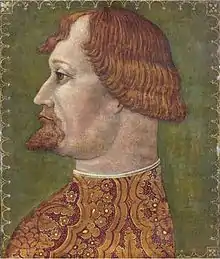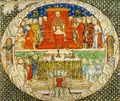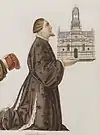Gian Galeazzo Visconti
Gian Galeazzo Visconti (16 October 1351 – 3 September 1402), was the first duke of Milan (1395)[lower-alpha 1] and ruled the late-medieval city just before the dawn of the Renaissance. He was the founding patron of the Certosa di Pavia, completing the Visconti Castle at Pavia begun by his father and furthering work on the Duomo of Milan.
| Gian Galeazzo Visconti | |
|---|---|
 | |
| Duke of Milan | |
| Tenure | 5 September 1395 – 3 September 1402 |
| Coronation | 5 September 1395, Basilica of Sant'Ambrogio |
| Successor | Gian Maria Visconti |
| Lord of Milan | |
| Tenure | 6 May 1385 – 5 September 1395 |
| Predecessor | Bernabò Visconti |
| Lord of Pavia | |
| Tenure | 4 August 1378 – 5 September 1395 |
| Predecessor | Galeazzo II Visconti |
| Lord of Pisa | |
| Tenure | 13 February 1399 – 3 September 1402 |
| Predecessor | Gherardo Appiani |
| Successor | Gabriele Maria Visconti |
| Born | 16 October 1351 Pavia, Italy |
| Died | 3 September 1402 (aged 50) Melegnano, Duchy of Milan, Italy |
| Burial | |
| Spouse | |
| Issue | Valentina Visconti Gian Maria Visconti Filippo Maria Visconti Gabriele Maria Visconti Antonio Visconti |
| House | Visconti |
| Father | Galeazzo II Visconti |
| Mother | Bianca of Savoy |
| Religion | Roman Catholicism |
Biography
During his patronage of the Visconti Castle, he contributed to the growth of the collection of scientific treatises and richly illuminated manuscripts in the Visconti Library.[1]
Gian Galeazzo was the son of Galeazzo II Visconti and Bianca of Savoy.[2] His father possessed the signoria of the city of Pavia. In 1385 Gian Galeazzo gained control of Milan by overthrowing his uncle Bernabò through treacherous means by faking a religious conversion and ambushing him during a religious procession in Milan.[3] He imprisoned his uncle who soon died, supposedly poisoned on his orders.[4]
Marriage and issue
His first marriage was to Isabelle of Valois,[5] who brought him the title of comte de Vertus in Champagne, rendered in Italian as Conte di Virtù, the title by which he was known in his early career. They had:
- Gian Galeazzo (b. Pavia, 4 March 1366 – d. bef. 1376).
- Azzone (b. Pavia, 1368 – d. Pavia, 4 October 1381).
- Valentina (b. Pavia, 1371 – d. Château de Blois, Loir-et-Cher, 14 December 1408), married on 17 August 1389 to Louis I, Duke of Orléans[5]
- Carlo (b. Pavia, 11 September 1373 – d. Pavia, 1374).
After Galeazzo's wife Isabelle died in childbirth in 1373, he married secondly, on 2 October 1380, his first cousin Caterina Visconti,[5] daughter of Bernabò; with her he had:
Conflict with France
Galeazzo was a devoted father to his daughter Valentina. He reacted to gossip about Valentina at the French Court by threatening to declare war on France. The wife of King Charles VI of France was Isabeau of Bavaria, the granddaughter of Bernabò Visconti, and, thus, a bitter rival of Valentina and her father Gian Galeazzo Visconti.
Galeazzo's role as a statesman also took other forms. Soon after seizing Milan he took Verona, Vicenza, and Padua, establishing himself as Signore of each, and soon controlled almost the entire valley of the Po, including Piacenza where in 1393 he gave the feudal power to Confalonieri Family on the lands they already had in the valleys around Piacenza. He lost Padua in 1390, when it reverted to Francesco Novello da Carrara. He received the title of Duke of Milan from Wenceslaus, King of the Romans in 1395 for 100,000 florins.
In 1396, after the disaster of Nicopolis, Galeazzo was strongly suspected of having informed the Ottomans of the crusaders' plans and of the size and strength of their army as vengeance for his daughter being accused of being behind the illness of King Charles VI of France, and for France's increasing control over the city of Genoa that he had attempted to hamper, for which he had been rebuked by Enguerrand VII de Coucy before the battle.
In 1400, Gian Galeazzo appointed a host of clerks and departments entrusted with improving the public health. For the new system of administration and bookkeeping this established, he is credited with creating the first modern bureaucracy, with the assistance of his Chancellor Francesco Barbavara.[6]
Uniting Italy
Gian Galeazzo had dreams of uniting all of northern Italy into one kingdom, a revived Lombard empire. Obstacles included Bologna and especially Florence. In 1402, Gian Galeazzo launched assaults upon these cities. The warfare was extremely costly on both sides, but it was universally believed the Milanese would emerge victorious. The Florentine leaders, especially the chancellor Coluccio Salutati worked successfully to rally the people of Florence, but the Florentines were being taxed hard by famine, disease, and poverty. Galeazzo won another victory over the Bolognese at the Battle of Casalecchio on 26 June 1402.
Galeazzo's dreams were to come to naught, however, as he succumbed to a fever at the castello of Melegnano on 10 August 1402. He died on 3 September. His empire fragmented as infighting among his successors wrecked Milan, partly through his division of his lands among both legitimate and illegitimate children.[lower-alpha 2]
Gian Galeazzo spent 300,000 golden florins in attempting to turn from their courses the rivers Mincio from Mantua and the Brenta from Padua, in order to render those cities helpless before the force of his arms.
Notable are his library, housed in the grandest princely dwelling in Italy, the castello in Pavia, and his rich collection of manuscripts, many of them the fruits of his conquests.
Furious at French political maneuvering that had removed Genoa from his influence, Gian Galeazzo had been attempting to stop the transfer of Genoese sovereignty to France and Coucy was dispatched to warn him that France would consider further interference a hostile act. The quarrel was more than political. Valentina Visconti, the wife of the Duke of Orleans and Gian Galeazzo's beloved daughter, had been exiled from Paris due to the machinations of Queen Isabeau the same month as the departure of the crusade. The Duke of Milan threatened to send knights to defend his daughter's honor but, in the wake of the disaster at Nicopolis, it was widely believed that he had relayed intelligence to Bayezid I of crusader troop movements. There is no firm evidence of this and it is likely that Gian Galeazzo became a scapegoat after the fact due to the existing animosity with France, though there remains the possibility that the Duke of Milan, who had murdered his own uncle to ensure his own power, did in fact betray the crusaders. Coucy, his diplomatic mission complete and accompanied by Henry of Bar and their followers, left Milan for Venice, from where he requisitioned a ship on 17 May to take him across the Adriatic Sea, landing in the Croatian port of Senj on 30 May before making his way overland to the rendezvous in Buda. (Battle of Nicopolis)
Gallery
 The painted figures of Caterina and Gian Galeazzo are shown kneeling in the foreground in this missal by Anovelo da Imbonate
The painted figures of Caterina and Gian Galeazzo are shown kneeling in the foreground in this missal by Anovelo da Imbonate The Coronation of Gian Galeazzo Visconti in the Basilica of Sant'Ambrogio
The Coronation of Gian Galeazzo Visconti in the Basilica of Sant'Ambrogio Gian Galeazzo Visconti, with his three sons, presents the Certosa di Pavia to the Virgin (Certosa di Pavia)
Gian Galeazzo Visconti, with his three sons, presents the Certosa di Pavia to the Virgin (Certosa di Pavia) Detail from Gian Galeazzo donates the Certosa to the Madonna
Detail from Gian Galeazzo donates the Certosa to the Madonna Tomb of Gian Galeazzo Visconti at the Certosa di Pavia
Tomb of Gian Galeazzo Visconti at the Certosa di Pavia
See also
Notes
- He was also Signore di Verona, Cremona, Bergamo, Brescia, Belluno, Pieve di Cadore, Feltre, Pavia, Novara, Como, Lodi, Vercelli, Alba, Asti, Pontremoli, Tortona, Alessandria, Valenza, Piacenza, Parma, Reggio Emilia, Vicenza, Vigevano, Borgo San Donnino and of the valli del Boite.
- To his son Giovanni Maria he assigned the title of Duke of Milan, which included Como, Lodi, Cremona, Bergamo, Brescia, Reggio Emilia, Piacenza, Parma, and claims to Perugia and Siena. To Filippo Maria, conte di Pavia, he assigned in addition Vercelli, Novara, Alessandria, Tortona, Feltre, Verona, Vicenza, Bassano and the shores of Trento. To his illegitimate son, Gabriele Maria, went Pisa and Crema.
References
- Hoeniger, Cathleen. The Illuminated Tacuinum sanitatis Manuscripts from Northern Italy ca. 1380-1400: Sources, Patrons, and the Creation of a new Pictorial Genre. in: Givens, Jean Ann; Reeds, Karen; Touwaide, Alain. (2006) Visualizing medieval medicine and natural history, 1200-1550. Ashgate Publishing Ltd. pp. 51-82. ISBN 0754652963.
- Mueller 2019, p. 550.
- John T. Paoletta and Gary M. Radke, Art in Renaissance Italy
- Barbara Tuchman A Distant Mirror A.A.Knopf, New York (1978) p.418
- Ward, Prothero & Leathes 1934, p. table 68.
- Symonds, John Addington (1888) [1875]. Renaissance in Italy: The age of despots. 1 (American ed.). New York: Henry Holt and Company. p. 142. ASIN B003YH9WF0. hdl:2027/mdp.39015026749849. OCLC 664406875. Retrieved March 8, 2011.
It was he who invented bureaucracy by creating a special class of paid clerks and secretaries of departments. Their duty consisted in committing to books and ledgers the minutest items of his private expenditure and the outgoings of his public purse; in noting the details of the several taxes, so as to be able to present a survey of the whole state revenue; and in recording the names and qualities and claims of his generals, captains, and officials.
Sources
- Mueller, Reinhold C. (2019). The Venetian Money Market: Banks, Panics, and the Public Debt, 1200-1500. The Johns Hopkins University Press.
- Ward, A.W.; Prothero, G.W.; Leathes, Stanley, eds. (1934). The Cambridge Modern History. XIII. Cambridge at the University Press.
Further reading
- Bueno de Mesquita, D. M. (Daniel Meredith) (2011) [1941]. Giangaleazzo Visconti, Duke of Milan (1351-1402): A Study in the Political Career of an Italian Despot (reprint ed.). Cambridge, UK: Cambridge University Press. ISBN 9780521234559. OCLC 746456124.
External links
| Italian nobility | ||
|---|---|---|
| Preceded by Galeazzo II Visconti Bernabò Visconti |
Lord of Milan 1378–1395 |
Became duke |
| New creation | Duke of Milan 1395–1402 |
Succeeded by Gian Maria Visconti |
.svg.png.webp)